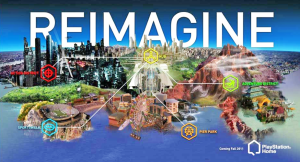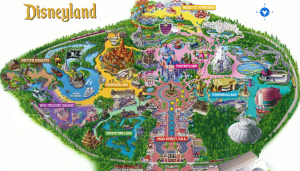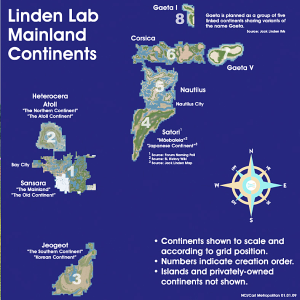Home From Scratch: Geography
by SealWyf, HSM Editor
In my previous article, I proposed a challenge: suppose you were tasked with designing a successor to Home, the social MMO that could take Home’s place, if it does not survive into the era of the PS4. Which features of Home would you include? Which would you discard? And which would you keep, but with improvements?
This article is about geography: the metaphor of place, and how we navigate in a virtual world. It may seem like a strange and esoteric topic for my first “Home from Scratch” suggestion, but I believe it is extremely important.
In something as abstract as a computer network, we need a strong metaphor to organize our experiences. One of the strongest metaphors we have is that of being in a physical place. It is so compelling that we often forget it is a metaphor at all. On a subjective level, it can feel as if we have actually been transported to another location. We know that our physical body is sitting on the couch, holding a controller. But we are “really” in Central Plaza, or the Hub, or Acorn Meadows Park. The metaphor is stronger than our sense of physical reality.
Home is a place-driven metaphor, but there is no overlying map. With rare exceptions, we must move from world to world through the Navigator, in unconnected, illogical jumps. You select a place, and you teleport to it. And, bang, you are there.
But real life has no teleporters. To get from one place to another, you must travel through all the places in between, traversing an imagined map. Most RPG’s or sandbox type games use the world map convention. If you are here, and want to go there, you must travel. This convention is relaxed in games with massive landscapes, where traveling would be tedious. In these, you are allowed to teleport to any place you have already visited by selecting it on the world map. But there is a map, and you are conscious of how the various places on it relate to each other, and where you are at any given time. The metaphor of geography is preserved.
One thing that bothers many newcomers about Home is the lack of a unifying map. It’s easy to get lost here. There are a lot of public spaces, and they have very little to do with each other. It’s geographical chaos. There’s only the list of spaces on the Navigator, in alphabetical order.
The Home Core Spaces project attempted to impose some order on the chaos of unrelated worlds, but with little success. The Hub is even less intuitively connected to other places in Home than the old Central Plaza, which used the metaphor of storefronts and doors. From Central Plaza, it was obvious how to get to the Bowling Alley, the Theater, the Mall, or your own Harbour Studio apartment. In the Hub, there is a labeled elevator to the Mall, and there are usually several temporary portals that take you directly to new attractions. Off to one side, there is a generic teleporter that transports you to the various sub-hubs, the Mall, and the Theater. But, despite the constantly passing trains, there is no sense of being in a transportation hub. Everything is disconnected. For most destinations, you must return to the Navigator and its alphabetical list.
In a way, it has to be that way. Home spaces are created by different developers, and even those from the same developer rarely have a coherent theme. Where is the Paradise Springs Casino relative to Black Powder Cove? Is Sodium Hub nearby, or is it on a different continent? Is Novus Prime in orbit above them? And where on earth (or any number of parallel Earths) does Aurora fit in? With its collection of completely unrelated public spaces, Home has no alternative to using the Navigator model, at the expense of a sense of place and geography.
But if a new world were being designed from scratch, geography could be imposed on it. The real-world park of Disneyland, which over the years has included content ranging from fairytale castles to jungle rivers to Caribbean pirates to futuristic lunar excursions to a scale model of the Matterhorn, organized its chaotic attractions into themed quadrants, which were all connected to the generic American hub of Main Street and linked by a perimeter train.
I think the Disneyland model is what the Home Core Spaces project was aiming at, with the Hub as Home’s Main Street, and the other core spaces (Pier Park, Sportswalk, the Action District, the Adventure District and the Mall) as its themed sub-quadrants. The problem was, very few of Home’s other spaces could be reached from the core. And the core spaces themselves were not particularly interesting. There was no real reason to go there except to reach temporary attractions, such as the cycle of seasonal games and rewards in Pier Park.
The Hub may be Home’s core, but it’s not its heart — not in the same way that Central Plaza was. And at least part of the problem is the Hub’s lack of orientation, connectivity, and a sense of geography.
Second Life, the massive PC-based social MMO, also has a geography, but it uses a very different model. There, every creation has been fit (with variable success) onto an underlying map of loosely themed areas organized into islands and continents. There is no central hub. This system has the advantage of being extensible — if you run out of room, you can always add another continent. And new continents are always under development.
As a Second Life user, you can teleport around the map at will. But you can also choose to travel overland, discovering the unsuspected attractions that lie between Point A and Point B. This can be fascinating, but it can take some time. It is no coincidence that the most commonly used locomotion in Second Life is flight.
And so my first recommendation to any designer of a new social MMO is, “seriously consider an underlying map.” This may seem trivial and troublesome. After all, we are all on the Internet here. Why should we pretend that one virtual space is anywhere near another?
To which I would reply that the illusion of reality is your strongest tool for community cohesion. You have to persuade people that when they are in your world, they are, in some sense, elsewhere. And the metaphor of a coherent geography is one of the most powerful ways to create that illusion. Consider it.
But that’s just me, and my opinion. What do you, the readers, think? Would you like Home any better if you could get on the perimeter train and move from Adventureland to Fantasyland to Tomorrowland? Or if you could walk to any Home public space “cross-country”, enjoying the sights along the way? Or does the Navigator, with its alphabetical list of attractions, work just fine for you?
And, my second question — if you were to visit a new social MMO, would you expect it to have a map?
Share
| Tweet |






I would expect a map.
And resonable means to get where I was going, from any of those locations on said map.
I really look forward to the future. Fabulous article series Seal. Keep at it!
Second life is a nightmare travelling, it is massive and impossible to get from place to place by real life methods as thats all you would be doing is travelling, Better off just jumping between spaces. The one thing that nearly all the other social mmos have, that home doesnt, is spaces set up for what social group you wanna join in on. Second life I can go to a space thats reserved for users that are virtual vampires and they can bite you if your not a vampire and turn you, the music in the background sets the feel and its dark urban zone. Or if I wanna go ballroom dancing I can, the music and room sets that feel again. nearly every area has a theme that users can relate to, not like home where lots of spaces where there really isnt a theme except trying to advertise something or sell you something. Dont get me wrong there are warehouse loads of goods sold in other social mmos but there tend to be set around a social theme like music tastes or lifestyle tastes
Interesting idea Seal, but I tend to agree with Gary. I think a map like that would have the drawback of distance. In Red Dead Redemption for example you can take stage coaches or trains to reach a destination, it is okay sometimes to sit an look at the scenery but it takes way too long, so most of the time you just jump to where you want to go or choose the option of jumping while in the train or coach. The same is true in Skyrim, once you get all of the major cities mapped by taking a wagon ride you can explore much easier.
I think that though the idea of having a cohesive map is great, it might also limit the development of the MMO because too big would equal too much work to get around and turn people off. The only way I can see it working is if you are given the options like the aforementioned games to jump or ride. Nice article!
How about a virtual tour guide? Someone to guide you through the initial map? The tour guide could be an interactive game that asks the user questions, and uses the answers to guide the person to certain spaces.
For example…the tour guide asks: “do you like dancing?…let me show you some spaces with dance floors. While we are visiting, I can show you how to use your controller to dance…”
I like that idea. It should be quite possible with the current technology, even if only as a set of slide shows. Having NPC guide characters in various spaces should be possible as well — they could be like the NPC characters in the Heavy Water spaces, especially D2O.